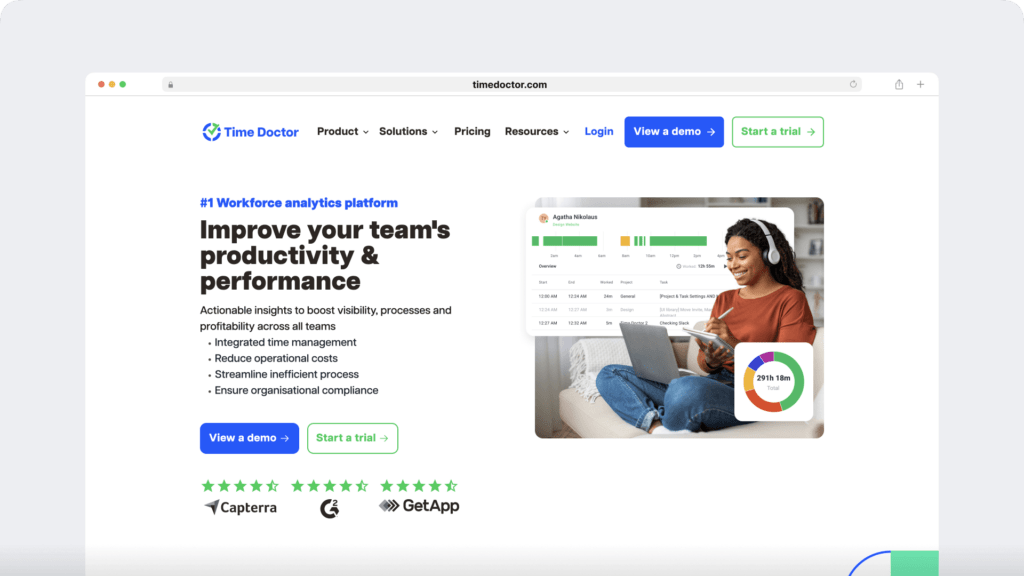If your team appears busy, are they truly productive or just giving the appearance of being so?
That question deserves more attention. Many leaders still equate activity with impact, but that’s like measuring a workout by how much someone sweats instead of how much stronger they get.
It looks impressive, yet tells you little about long-term progress.
Say a team logs 42 hours this week. On paper, it sounds productive. However, if most of that time is spent on low-priority tasks, status updates, or constant tool switching, those hours may fill space but do little to support meaningful progress.
In this article, we’ll unpack four productivity myths that continue to shape how companies evaluate performance.
These myths influence how leaders reward teams, assess contributions, manage time and plan for growth across remote, hybrid, and in-office environments.
Modern workforce analytics reveal a different story. In fact, for many teams, the truth has been hiding in plain sight.
That’s why it’s worth revisiting the assumptions we still treat as fact. Let’s take a closer look at four productivity myths that continue to shape how teams are measured and why it’s time to rethink them.
What we’ll cover
Myth 1: Online equals productive
The green dot in Slack or Teams might signal activity, but it does not reflect value. Being “active” does not necessarily mean progress is being made.
Research by DemandSage shows the average office worker is productive for only 2 hours and 53 minutes during an 8-hour workday.
That means over five hours are often spent on low-impact tasks, unnecessary check-ins, or switching between tools, despite appearing online the entire time.
Workforce analytics reveal this mismatch clearly. Presence and performance are not the same. Many teams have discovered that real output begins when distractions are reduced and priorities align with goals.
We explored this in depth during our latest webinar. Watch the recording here to see how presence-based assumptions can lead to misleading productivity data.
Myth 2: More output means more progress
When it comes to performance, more isn’t always better. In fact, high output can sometimes mask shallow work. It’s a bit like filling a shopping cart quickly. Speed may look impressive, but what truly matters is what’s actually inside.
Some of your top performers may appear less active on the surface, yet they contribute deeper thinking, better strategy, and stronger outcomes.
One tech company discovered that its highest-performing engineers showed more idle time than their peers, but consistently delivered better results.
Their value came not from rapid output, but from problem-solving, planning, and building smarter.
According to Safety4Sea, multitasking, or more accurately, task-switching can reduce productivity by up to 40%. Rapid task-jumping creates the illusion of progress while draining focus and attention.
Workforce analytics help leaders see beyond the surface. They provide visibility into how time is actually spent and reveal patterns of deep work that may not show up in basic activity logs.
Myth 3: Everyone contributes equally
When every team member seems busy, it’s tempting to believe the work is evenly shared. Yet workforce analytics often reveals a very different pattern. In many cases, leaders only recognise it once it begins to affect outcomes.
In one organisation, everything appeared balanced on the surface. However, after a key team member resigned, a deeper analysis revealed a significant gap: only 20% of employees were responsible for more than 70% of the team’s productive output.
For months, the imbalance had gone unnoticed. The quiet high-performers were carrying far more than anyone realised.
Assuming that everyone is contributing equally can be misleading, especially when there is no reliable employee time tracking across a distributed workforce.
Without clear visibility, leaders may overlook early signs of burnout, uneven workload, or missed recognition for high performers.
This is where workforce analytics changes the story. By revealing patterns hidden in day-to-day activity, it helps leaders uncover quiet contributors, identify uneven workloads early, and surface the kind of insights that traditional metrics often miss.
It also makes it easier to plan with confidence and avoid performance surprises.
Myth 4: Tracking equals micromanagement
For a long time, tracking was seen as a control tactic. But that assumption is starting to shift.
More teams are learning that employee monitoring, when used with purpose, doesn’t have to feel invasive. It can actually fuel clarity and confidence.
Modern workforce analytics provide shared visibility into how work is done. When team members and managers can access these insights, they begin making smarter adjustments, building better habits, and focusing their energy where it matters most.
One solutions leader described the shift like this:
“I used to think it was about control. Now I use it to coach myself.”
This story isn’t unique. As teams gain access to real-time insights, many discover that what once felt like oversight now feels like support.
Instead of guessing, they plan with confidence. Instead of being monitored, they lead with clarity.
What teams discovered with Time Doctor

The myths we explored in this article aren’t just theories. They’re assumptions real companies once believed, until the data showed them something unexpected.
Time Doctor features provide leaders with a way to replace guesswork with insight, utilizing workforce analytics that reveal what’s actually driving team performance.
Here’s how Time Doctor helps uncover those truths:
1. Activity now leads to insight
Some leaders were surprised to find that highly active teams weren’t always the most productive. With Time Doctor, they could see:
- Where focus time was truly being spent
- Which tools and tasks created flow or caused friction
- When shallow work was crowding out strategic thinking
This helped teams shift from measuring presence to measuring purpose.
2. Data helped reveal hidden pressure
Many customers discovered that missed breaks, late-night sessions, and rising hours were going unnoticed. With Time Doctor’s help, they were able to:
- Detect early signs of overload
- Rebalance assignments before burnout sets in
- Support a healthier rhythm across hybrid and distributed teams
What appeared to be a strong commitment was sometimes an early indication of strain.
3. Top contributors often worked quietly
In multiple cases, customers realised that their most consistent and high-value team members weren’t always the most visible. Time Doctor helped them spot:
- Reliable, focused work happening in the background
- Trends in task completion and time investment
- Subtle shifts that pointed to engagement or exhaustion
These insights made recognition more meaningful and more accurate.
4. Transparency strengthened trust
Some teams hesitated at first, unsure how they would feel about tracking. However, Time Doctor’s approach demonstrated that visibility built with people in mind fosters alignment and encourages shared ownership.
Customers now use features like:
- Privacy-conscious screen monitoring
- Role-based access
- Dashboards built for leaders, not surveillance
This gave both managers and employees the context they needed to lead with confidence and clarity together.
Ready to see what your data reveals?
Get a Demo to discover how workforce analytics can help your team uncover patterns, protect performance, and lead with trust.

Carlo Borja is the Content Marketing Manager of Time Doctor, a workforce analytics software for distributed teams. He is a remote work advocate, a father and an avid coffee drinker.


